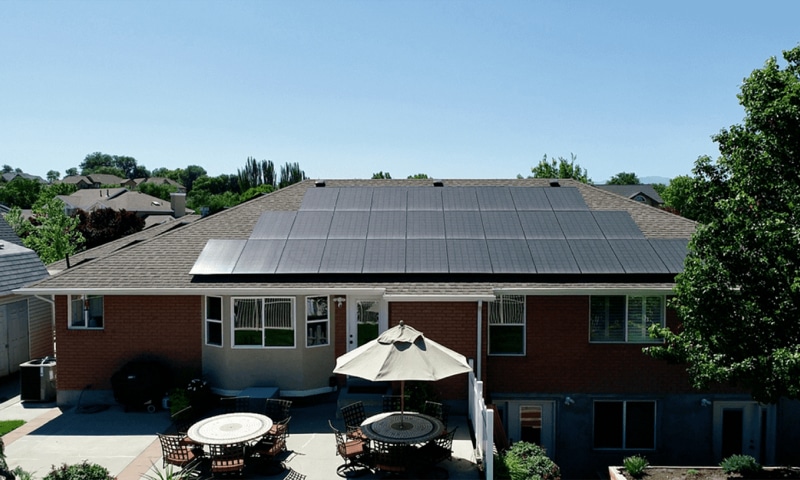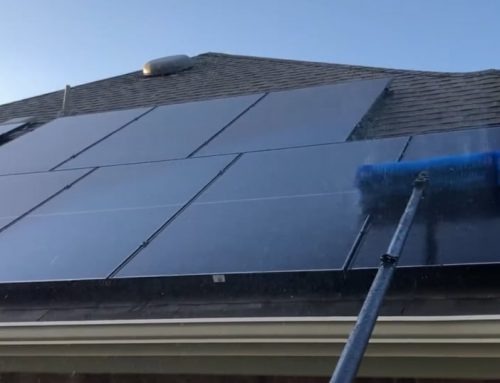Imagine tapping into the renewable energy of the sun to power your home or business.
OK, now stop imagining it.
Thanks to advancements in solar technology, this is now a reality for your Adelaide home or business.
At the forefront of this green revolution are two key players:
Monocrystalline and Polycrystalline solar panels.
Both types of solar panels are champions in converting solar energy into electricity, but each has its unique characteristics and advantages.
In this article, you will read:
- Overview of Monocrystalline and Polycrystalline Panels
- Comparison of Monocrystalline vs Polycrystalline Panels
- Matching Panels to Installations
ENERGY BUSTER TIPS:
|
In this article, we’ll dive deeper into the intricacies of Monocrystalline and Polycrystalline solar panels. You’ll discover how each type functions, their pros and cons, and which might be the best fit for your energy needs.
Let’s get right into it.
Monocrystalline vs Polycrystalline Panels
| Feature | Monocrystalline Solar Panels | Polycrystalline Solar Panels |
| Appearance | Uniform dark color, sleek and aesthetically pleasing | Blue, speckled look |
| Material | Single-crystal silicon | Multiple silicon crystals fused |
| Efficiency | Higher efficiency, performs well even in low-light conditions | Slightly less efficient, less effective in low-light conditions |
| Cost | Higher due to complex production processes | Lower due to simpler, more cost-effective production |
| Environmental Impact | More waste during production, less environmentally friendly manufacturing | Less waste during production, more environmentally friendly manufacturing |
| Lifespan | Longer lifespan due to high purity of silicon | Standard lifespan compared to monocrystalline panels |
| Temperature Sensitivity | More sensitive to high temperatures | Standard temperature sensitivity |
| Aesthetic Integration | Blends seamlessly with rooftops | Might not blend well with certain roofing styles |
| Space Requirement | Ideal for limited spaces due to higher efficiency | Requires more space for the same output due to lower efficiency |
Monocrystalline Solar Panels
Monocrystalline solar panels are the epitome of solar efficiency and aesthetics.
Crafted from single-crystal silicon, they boast a uniform dark colour and a reputation for top-tier performance. These panels are particularly adept at converting sunlight into electricity, even in less-than-ideal lighting conditions.
Pros:
- Higher Efficiency: Monocrystalline panels often achieve higher efficiency ratings, making them ideal for areas with limited space.
- Better Performance in Low Light: Their single-crystal structure allows for better performance in low-light conditions and cloudy weather.
- Longer Lifespan: They tend to have a longer lifespan due to the high purity of silicon, offering a better long-term investment.
- Aesthetically Pleasing: The sleek, black design of these panels often blends more seamlessly with rooftops.
Cons:
- Higher Cost: The process of creating single-crystal silicon is more complex, leading to higher prices for these panels.
- Waste in Production: The production process results in significant silicon waste, making them less environmentally friendly in manufacturing.
- Temperature Sensitivity: They can be slightly more sensitive to high temperatures, which might affect performance during heat waves.
Polycrystalline Solar Panels
Polycrystalline solar panels, recognisable by their blue, speckled look, are made from multiple silicon crystals fused.
They offer a more budget-friendly solution for solar energy, making them accessible to a wider range of customers.
Pros:
- Lower Cost: The manufacturing process is simpler and more cost-effective, resulting in lower prices for consumers.
- Less Waste in Production: Their production generates less waste compared to monocrystalline panels, making them a more environmentally friendly choice.
- Good Efficiency: While slightly less efficient than monocrystalline panels, they still provide substantial energy output for most residential needs.
Cons:
- Lower Efficiency: Due to their polycrystalline nature, these panels have a lower efficiency rate, requiring more space for the same output as monocrystalline panels.
- Aesthetic Differences: Their blue, speckled appearance might not blend as well with certain roofing styles.
- Performance in Low Light: They may not perform as efficiently in low-light conditions compared to monocrystalline panels.
Choosing Your Solar Panel: A Comparison
Selecting the right solar panel is more than just a matter of preference; it’s about understanding how different factors can influence your decision.
Let’s compare Monocrystalline and Polycrystalline solar panels across several crucial aspects: efficiency, cost, durability and lifespan, aesthetics, and environmental impact.
| Criteria | Monocrystalline Solar Panels | Polycrystalline Solar Panels |
| Efficiency | High efficiency, ideal for limited space as fewer panels are needed for the same output. | Slightly less efficient, suitable for larger spaces where panel number isn’t restricted. |
| Cost | More expensive initially but cost-effective in the long run due to higher efficiency and lifespan. | Budget-friendly with a lower initial cost, accessible for a broader range of budgets. |
| Durability and Lifespan | Known for longevity, often with longer warranties and a lifespan of 25 years or more. | Durable but may have a slightly quicker decline in efficiency over the years. |
| Aesthetics | Sleek, black design integrates well with various architectural styles, aesthetically pleasing. | Blue, speckled appearance might be less appealing depending on personal taste. |
| Environmental Impact | More energy-intensive production with more waste, may concern environmentally conscious consumers. | Slightly better environmental score due to a more efficient manufacturing process. |
| Additional Considerations | Preferable in smaller or shaded areas, sensitive to high temperatures which could affect performance in hot climates. | More suitable for larger, sunnier spaces, less sensitive to temperature variations. |
Efficiency
- Monocrystalline: They excel in efficiency, often converting more sunlight into electricity than polycrystalline panels. This makes them ideal for areas with limited space, as you’ll need fewer panels to achieve the same energy output.
- Polycrystalline: While they have improved over the years, these panels still lag slightly behind in efficiency. They’re a practical choice for larger spaces where the number of panels isn’t as restricted.
Cost
- Monocrystalline: Their higher efficiency and longer lifespan come at a premium. These panels are more expensive initially, but they can be a cost-effective choice in the long run, especially in space-constrained areas.
- Polycrystalline: More budget-friendly, these panels offer a lower initial investment, making them accessible for a broader range of budgets.
Durability and Lifespan
- Monocrystalline: Known for their longevity, these panels often come with longer warranties and can last upwards of 25 years or more, maintaining a high performance throughout their lifespan.
- Polycrystalline: They are also quite durable but might show a slightly quicker decline in efficiency over the years compared to monocrystalline panels.
Aesthetics
- Monocrystalline: With their sleek, black design, these panels often integrate more seamlessly into various architectural styles, offering an aesthetically pleasing solution.
- Polycrystalline: The blue, speckled appearance can be less visually appealing on certain rooftops, although this is subjective and depends on individual taste.
Environmental Impact
- Monocrystalline: The production process is more energy-intensive and results in more waste, which might be a concern for environmentally conscious consumers.
- Polycrystalline: They score slightly better in terms of environmental impact due to their more efficient manufacturing process.
Additional Factors
- The size of your installation area and the local climate are also important considerations. Monocrystalline panels might be preferable in smaller or shaded areas, while polycrystalline panels could be more suitable for larger, sunnier spaces.
- Consider the temperature tolerance of each type. Monocrystalline panels can be more sensitive to high temperatures, which could be a factor in very hot climates.
Solar Tailored to Your Needs: Matching Panels to Installations
When it comes to choosing the right type of solar panel, context is everything.
The effectiveness of monocrystalline and polycrystalline solar panels can vary greatly depending on the specifics of the installation site and your energy goals.
Residential Rooftop Installations
- Monocrystalline Panels: Best for smaller or irregularly shaped roofs due to their higher efficiency. They are an excellent choice for homes in areas with limited roof space or those that experience frequent overcast conditions.
- Polycrystalline Panels: Suitable for larger rooftops where space isn’t a constraint. They offer a more budget-friendly solution for homeowners who want to invest in solar energy without the higher upfront cost of monocrystalline panels.
Commercial and Industrial Installations
- Monocrystalline Panels: Ideal for large-scale commercial installations where space may be limited and maximising energy output is crucial. Their higher efficiency and longer lifespan can provide substantial long-term savings for businesses.
- Polycrystalline Panels: A viable option for commercial installations with ample rooftop or ground space. They allow for a significant reduction in initial investment, which can be appealing for businesses looking to minimise upfront costs.
Rural or Remote Applications
- Monocrystalline Panels: Particularly useful in off-grid installations where efficiency and space utilisation are critical. Their superior performance in low-light conditions makes them suitable for remote areas that may not receive consistent sunlight.
- Polycrystalline Panels: These can be a practical choice for larger off-grid installations, such as in agricultural settings, where the balance between cost and efficiency is a key consideration.
Understanding your specific needs and the characteristics of your installation site is crucial in choosing between monocrystalline and polycrystalline solar panels.
By considering the factors outlined above, you can select a solar panel type that not only fits your energy requirements but also optimises your investment.
Take the Next Step with Energy Buster
You’re now equipped with the knowledge to make an informed choice in your solar energy journey. But understanding your options is just the beginning.
The next step?
Bringing your solar dream to life with a solution that’s tailored specifically to your needs.
At Energy Buster, we believe in empowering our clients with customised solar solutions. Whether you’re leaning towards the high efficiency of monocrystalline panels or the cost-effectiveness of polycrystalline panels, our team is ready to guide you every step of the way.
Contact us for a personalised quote and expert advice. We’re here to help you assess your specific needs, explore your options, and ultimately find the perfect solar solution for your home or business.
Reach out to Energy Buster today and take control of your energy destiny!







